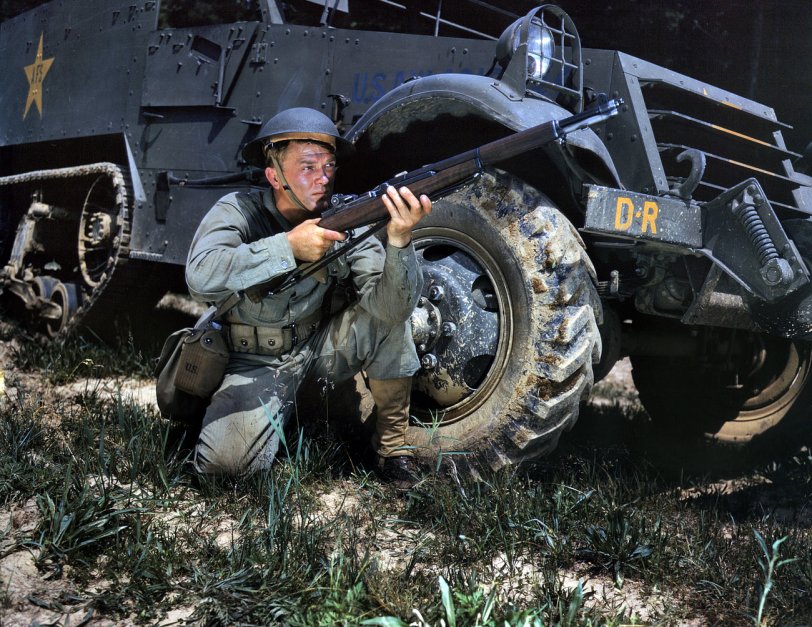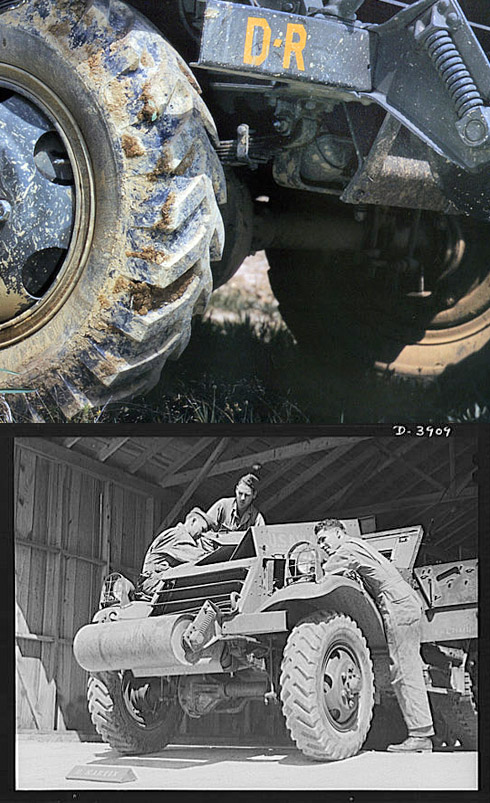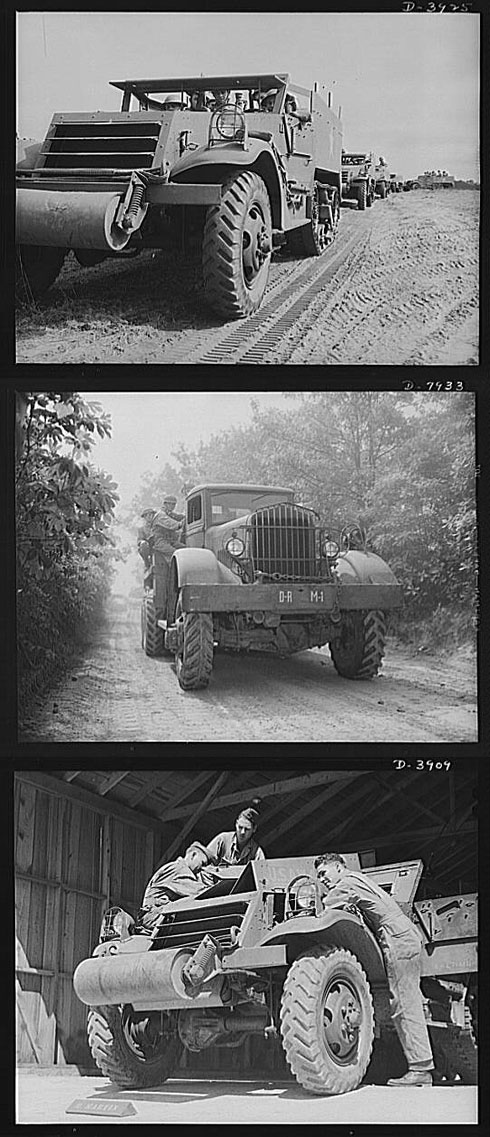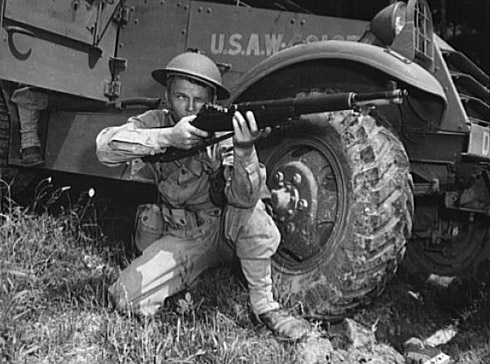


Framed or unframed, desk size to sofa size, printed by us in Arizona and Alabama since 2007. Explore now.
Shorpy is funded by you. Patreon contributors get an ad-free experience.
Learn more.

- Details, Details
- What's that building to the left of the tower?
- Coal Barges
- Bromo-Seltzer
- Inner harbor
- The Basin
- What a headache!
- Giant stepladder?
- Baldwin 62303
- Baldwin VO-1000
- Cold
- No expense spared
- Tough Guys
- Lost in Toyland
- And without gloves
- If I were a blindfolded time traveler
- Smoke Consumer Also Cooks
- Oh that stove!
- Possibly still there?
- What?!?
- $100 Reward
- Freeze Frame
- Texas Flyer wanted
- Just a Year Too Soon
- WWII -- Replacing men with women at the railroad crossing.
- Yes, Icing
- You kids drive me nuts!
- NOT An Easy Job
- I wonder
- Just add window boxes
Print Emporium
Old Reliable: 1942

June 1942. Fort Knox, Kentucky. "Infantryman with halftrack. A young soldier sights his Garand rifle like an old-timer. He likes the piece for its fine firing qualities and its rugged, dependable mechanism." 4x5 Kodachrome transparency by Alfred Palmer for the Office of War Information. View full size.
Bumper #
The "D-R" stands for demonstration Regiment.
It's a gas port all right
Agree, that's a gas port rifle. Gas trap rifles were in use as well, although they were to be refitted with the newer design parts when they were sent back for depot maintenance or overhaul. Note the early sight knob without the lock bar.
Only the Army had M1 Garands at this point. The Marines stuck to their trusty 1903 Springfield rifles until first-hand experience alongside the Army at Guadalcanal convinced them that the new design was preferable.
Note the mix of WW1 gear (belt, canteen and other gear), interwar helmet (WW1 metal, 1934-era liner) and new rifle and herringbone twill uniform. This was common then, and I admired the movie "The Thin Red Line" for getting that right.
M1 Garand
The Garand shown is in color photo is a Gas Port design and not the earlier Gas Trap design. http://www.fulton-armory.com/GasTrapGallery.htm
M1 Garand Rifle
The soldier in both the photo taken in June 1942 by A Palmer of the OWI, and this one, are members of the US Army. Both are wearing the M1937 helmet and their M1 Garands are the very early "gas trap" model. This system was was discontinued in July 1940 in favor of the "gas port" model which continued in use until production was finally discontinued in 1957 in favor of the M14 Rifle.
Both soldiers are wearing the obsolete helmet and using the obsolete rifle because they are probably participating in training field exercises. I suspect both photos were taken by Mr. Palmer, probably on the same day in June 1942 as it appears that the markings on the bumper indicate that it is the same half track.
Historical tires
Low pressure, pneumatic farm tires first appeared only 10 years before this photo was taken. Not long before the war, new tractor production had finally just made the switch over to majority rubber tires in place of steel wheels.
The first farm tires evolved from knobby aircraft tires into the 45 degree barred tires still common today. Many of the early barred farm tires had a tread connector strip down the center of the tire similar to the tires on your halftrack.
I don't know when the tread codes (R, F, I) first appeared but my guess is not until the 50s or 60s. Your halftrack tires are probably closer to what is today an R-4 tread rather than an R-1. The R-4 is directional and similar to the R-1 but has less open area.
At low speeds (under 12mph), the barred tire self-cleaning action comes as mud is forced from the center of the tire to the outside. Squished. Trust me, if you reverse a directional barred tire, this self-cleaning mechanism disappears quickly. The tires ball up with mud and won't self-clean run backwards until you get enough speed up (25mph+) to "throw" the mud off.
"Reid Gray" may have hit on your answer though. The tires may have also been run backwards to keep them clean and maintain front traction for steering. That makes more sense than anything I mentioned.
Keep up the good work. Thanks.
Rotation
You guys are amazing. Good point about not trying to second-guess military thinking on these matters--no doubt they did have their reasons. One might simply have been that the front wheels on halftracks run on paved roads would certainly wear unevenly, and with no back wheels to add to the mix the only way to rotate them is to run them with the treads going the other way for a while. Perhaps they were more likely to do this in conditions where dig-in was less of an issue, or when the front wheels were being used unpowered (though I don't know whether that was an option, as it was on my old Power Wagon). At least in training or other less time-critical situations, they could still switch them back before conditions were likely to get muddy. I'll bet there was a manual on this at one time.
This is speculation, but I'm wondering if the central tread ridge connection on the WW2 tires was perhaps designed to improve wear on pavement, since it puts a more or less continuous band of rubber on the part of the tire with the most road contact. I would think it might also help the tire retain its shape as it compresses on contact, which could also improve wear on pavement.
Related question: I've often wondered whether the powerful rear tracks on halftracks could sometimes overpower the steering capabilities of the front wheels in certain particularly loose conditions, especially since I understand most of the load is over those tracks. Thus the wisdom of driven front wheels--but I'm wondering if there was also an option to brake a rear track individually, as with a tank. I would think steering like that from both the front and rear would be the ultimate combination.
Stuck in the Mud
While I shouldn't try to second guess the military thinking of the day regarding which way to mount their front tires, I can report why we would occasionally run farm tires "backward".
The idea in mounting R-1 (chevron) tires backward was that you had better traction going in reverse than forward. Thus, with superior traction in reverse, you could (almost) always count on being able to back out after you got stuck. Yes, it also meant you were more likely to get stuck in the first place but the chances you'd have to call for a tow in that event were supposedly less likely.
While you wouldn't likely see this done on a tractor, it was fairly common to see it on combines. Especially in areas known for a wet harvest like Oklahoma wheat harvest or soybean harvest in Mississippi.
The other possibility for running their front tires backward might have had something do with wear issues. Chevron tires wear out quickly on pavement when run the "right" way. As I recall, the leading edge of the outside tread bar will wear away fast. By running the tires backwards, they may have found the tire treads wore down more evenly and lasted longer.
Well, just a thought anyway.
[Note that the WW2 tire and the R-1 tractor tread (below) are totally different designs. In the R-1 the tread is made of separate ridges. Which is what gives you traction and self-cleaning at the same time. You could put it on either way and get dig-in, either from the middle or from the edges. On the WW2 tire the ridges are all connected at the middle. The only dig-in is from the edges. - Dave]

Tire Treads
"This is the recommended mounting for a non-powered wheel, unfortunately it's on a driven axle."
I was not aware that the front axle on a half-track was a driven axle. In fact I don't think it was - the front wheels were for steering while the tracks provided power. You will observe on the photo of the truck (the middle of the three that Dave posted) the front tires was chevrons forward and the rear tires were chevrons back.
[As we can see from the axles and differential cases in the photos already posted, the front wheels are driven. - Dave]

Leave it to Shorpy
Leave it to Shorpy commentors to start a tire tread direction thread. Surprised me to realize I've never thought about it before, and I'm an old guy.
It would seem having the tread chevron point first as it contact a dry surface would provide a modicum of extra grabbing force. Although, as the below people noted, it would be gunked up immediately in mud and snow.
It's hard to imagine they'd stop and turn their treads every time the weather changed. Just choose one and live with it. So, it's easy to see where mult-directional treads would take care of having to make a call on the old treads and their direction. Solving problems, one of man's more useful abilities.
Can't believe I just wrote three short paragraphs on tire tread direction on large vehicles of long past decades. Maybe that's why I love this site. Brings out some unique discussions and responses at times.
The tire is on backward
Farm kids pick this stuff up early, with chevron-type tread like that on a powered wheel the bars won't self clean and the tire is effectively bald in mud or snow. This is the recommended mounting for a non-powered wheel, unfortunately it's on a driven axle. The government was in the process of changing to the more familiar NDT (Non Directional Tread) right about the time this picture was taken, it simplified maintainance and eliminated possible future issues like this halftrack might experience.
[If only you'd been there to tell them. And them and them and them. - Dave]

Tires on backward
If it was a drive wheel it is definitly on backwards. A drive tire put on this way would not be self cleaning. It would fill up with mud and lose traction. Put on correctly the tire will be self cleaning and retain traction. With non-drive tires the direction of the tread is irrevelant.
["Irrevelant"? See above. - Dave]
Tire's on backward
The directional tread on that tire's going the wrong way, so either the tire was put on the rim wrong or the right and left wheels were switched. The factory shots have them mounted correctly.
[I bet they knew what they were doing. See above. - Dave]
Helmet Transition
I have photos of my father in the Army in 1941 and 1942. In the early photos, in training in Alabama, he is wearing one of the doughboy style helmets. After the war started, there are photos of him in Hawaii in 1942 with the newer, more familiar GI style helmet.
Helmet
If I remember correctly, the US used those WWI/British style helmets until early 1942, when it switched to the more familiar "wrap around" helmet used through the rest of the war. I suppose the old helmets could still be used for training.
Garand Rifle
Interesting photo. Latest rifle, the Garand and a World War I type helmet. Looking at the markings on the vehicle, it doesn't seem to be US ARMY. Could it be US MARINE CORPS?
[U.S.A.W. - Dave]

























On Shorpy:
Today’s Top 5